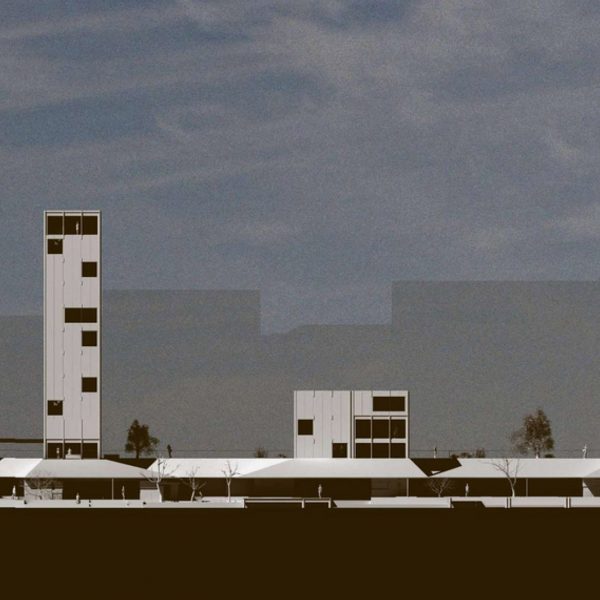Dezeen School Shows: a phone case that doubles as a board game to combat excessive use of social media is included in Dezeen’s latest school show by students at IE University.
Also included is a proposal for a transport system which utilises solar panels and rainwater collection. There’s also a project which uses the colour pink to promote sustainability within the fashion and textile industry.
Institution: IE University
School: IE School of Architecture and Design
Courses: Bachelor in Architectural Studies and Bachelor in Design
Tutor: David Goodman
School statement:
“In an international and entrepreneurial environment, IE School of Architecture and Design seeks to bridge the traditional gaps between academia and the professional world, fostering connections between creative industries and society at large.
“IE School of Architecture and Design redefines design education based on pedagogical and technological innovation, project-based learning and environmental and social responsibility.
“Our school serves as a hub for diverse creative fields.
“We boast a robust and innovative portfolio of programs within the creative industries.
“Our capabilities extend to a wide range of creative disciplines, including architecture, design, real estate development, interior design and fashion design, among others.”
Commodity of Land and Locals: Exotic Invasive Species by Alara Aykanat
“There can be a comparison between humans and exotic invasive species exhibiting our equal impact on areas we aren’t native to; even so, humans are invasive to the areas which they are native to.
“Thus, the idea of post-human infrastructures becomes a core for a world beyond the human and signals a need for anti-anthropocentric solutions.
“Drawing from the original understanding of ecology as oikos or the household, post-human infrastructures allow us to think about the role of non human creatures such as animals and plants as active co-creators of space.
“It evokes collaboration, entanglements and spatial modes of kinship with non-humans in the crafting of more sustainable built environments.”
Student: Alara Aykanat
Course: Design Studio 9: Synthesis
Tutor: Mariona Benedito Ribelles
Email: aaykanat.ieu2019[at]student.ie.edu
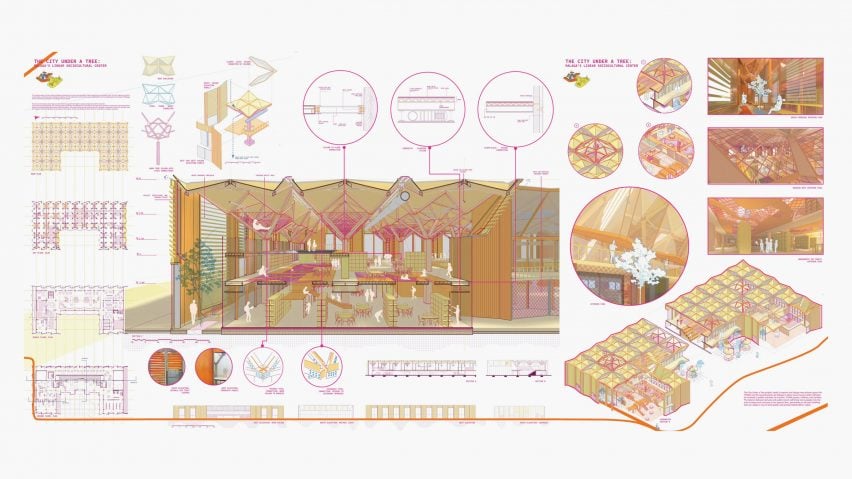
The City Under A Tree by Daniela Figueroa Rozotto
“The City Under a Tree is a project in Málaga aimed at creating private spaces for FYCMA and the city, generating income to support public activities.
“It balances private and public events, attracting a diverse audience all year round.
“By integrating temporary structures and permanent features, construction costs are minimised, while involving locals promotes social sustainability.
“The project uses research to schedule activities for families, tourists and event attendees, allowing FYCMA to host larger events.
“It encourages sustainable transport with improved bike paths and features eco-friendly systems like solar panels, rainwater collection and natural ventilation, making it a model for sustainable urban development.”
Student: Daniela Figueroa Rozotto
Course: Design Studio 9: Synthesis
Tutor: Izaskun Chinchilla
Email: d.figueroarozotto[at]student.ie.edu
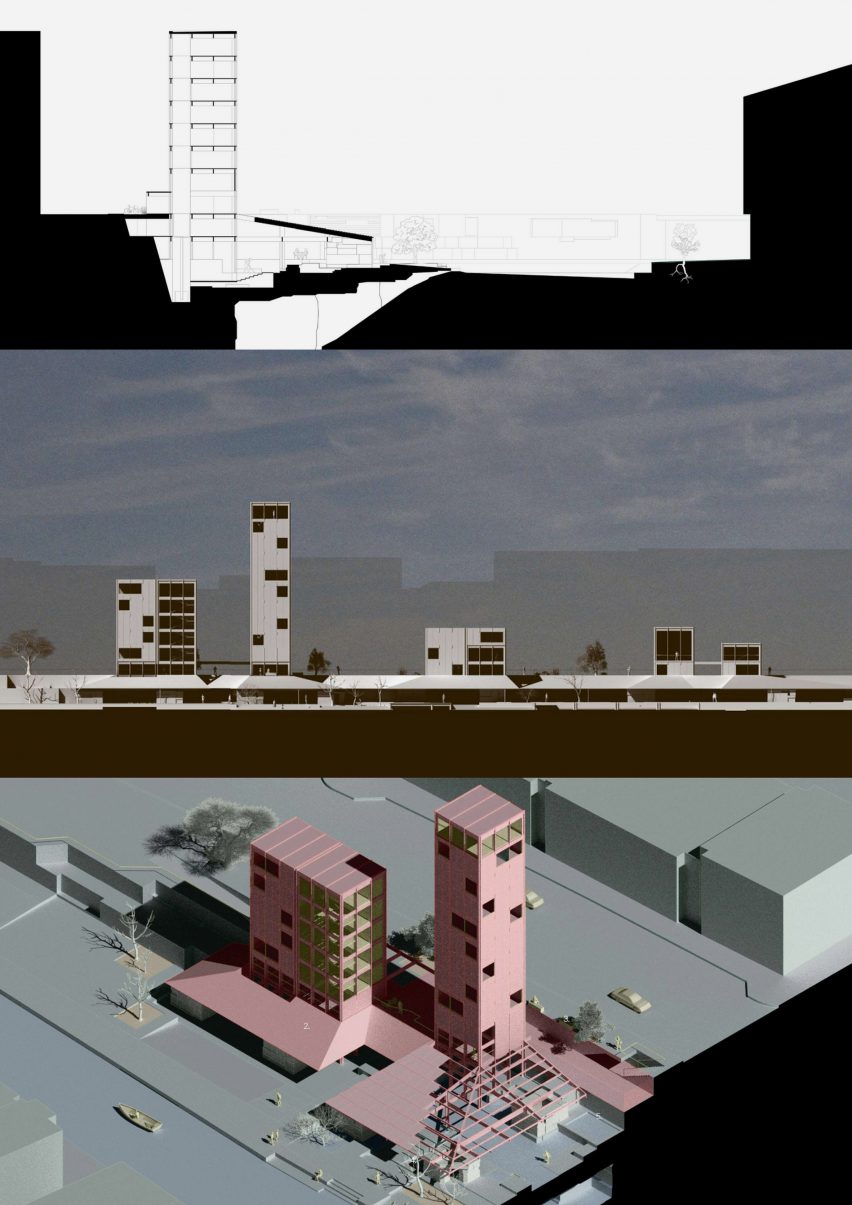
Sticks and Stones of [Flood + Drought] by Yusuf Sühan Bozkurt
“Sticks and Stones is an architectural project in Girona, Spain, designed to address climate extremes like floods and droughts.
“Using the act of limestone mining as a core concept, the project creates terraces that appear or disappear with changing water levels from the Onyar River.
“Excavated voids serve as flood reservoirs and transform into a community museum during droughts.
“The project fosters environmental awareness and community engagement through this dynamic relationship with water.
“Social housing is designed vertically to minimise environmental impact, allowing the site to evolve with future needs.”
Student: Yusuf Sühan Bozkurt
Course: Design Studio 9: Synthesis
Tutor: Mariona Benedito
Email: yusufsuhanbozkurt[at]student.ie.edu
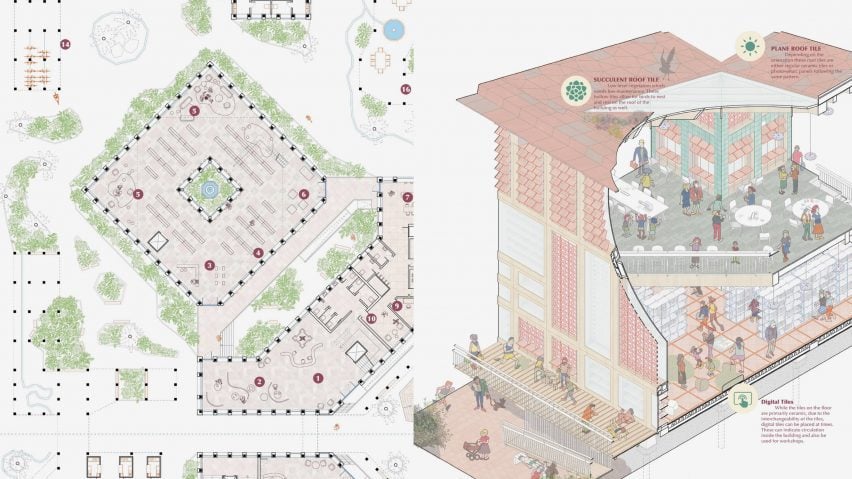
Mediateca San Andrés – Centro Cultural de Málaga by Daphne Fournel
“The project envisions a médiathèque in Málaga, aiming to represent the region’s cultural past and technological future.
“It will serve as a collaborative public-private space between the University of Málaga and local tech company ANOVO, fostering innovation and providing students with dedicated learning areas.
“Aligned with the Expo’s health city goal, the building integrates a cycling route through its structure and connects to the city’s metro and bus networks, promoting sustainable movement, whilst a public plaza will offer a space for both locals and tourists and be situated near the airport, city centre and beach.
“With 10 million annual visits to the nearby port, the building aims to reclaim part of the coastline for community use, creating learning spaces for residents.
“The design also incorporates the natural flow of the sea, allowing water to interact with the site without disrupting its natural movement, embracing the connection between the city and its coastal environment.”
Student: Daphne Fournel
Course: Design Studio 9: Synthesis
Tutor: Mariona Benedito
Email: dfournel.ieu2019[at]student.ie.edu
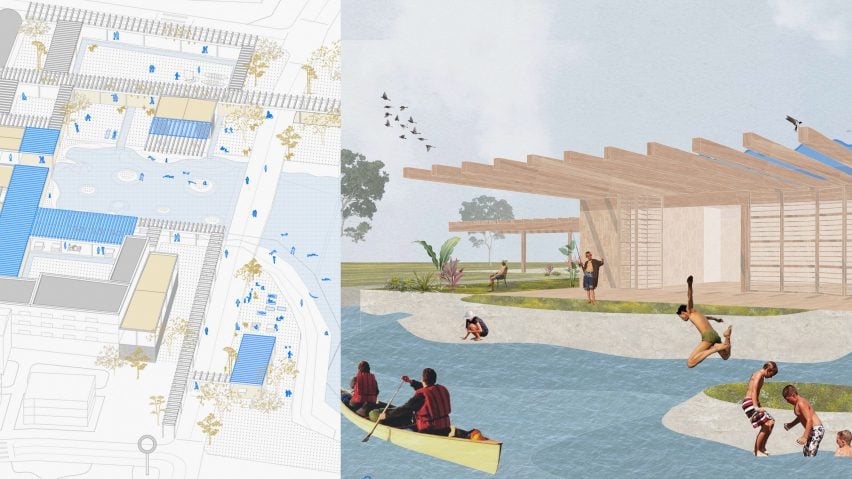
Wood on Wood by María Suárez-Pumariega Blanco
“The project aims to transform Zorrotzaurre Island in Bilbao by reconnecting the city with the Nervion River through the creation of a dynamic hybrid plaza that adapts to the tides.
“This multi-functional space can serve as a pool, plaza, or gathering spot, integrating water into the urban fabric and promoting sustainability.
“The design prioritises pedestrians and cyclists, preserving historical buildings while introducing new structures along the waterfront to activate the riverfront.
“The central plaza manages rainwater and includes flexible timber structures housing a café, sailing school and terrace. Sustainability features like solar panels, aerothermal energy and rainwater systems make the site self-sufficient.
“The project reimagines Bilbao’s relationship with the river, blending urban development with natural elements to create a fluid, adaptable urban environment.”
Student: María Suárez-Pumariega Blanco
Course: Design Studio 8: Territory
Tutor: Lola Domènech Oliva
Email: msuarezpumar.ieu2020[at]student.ie.edu
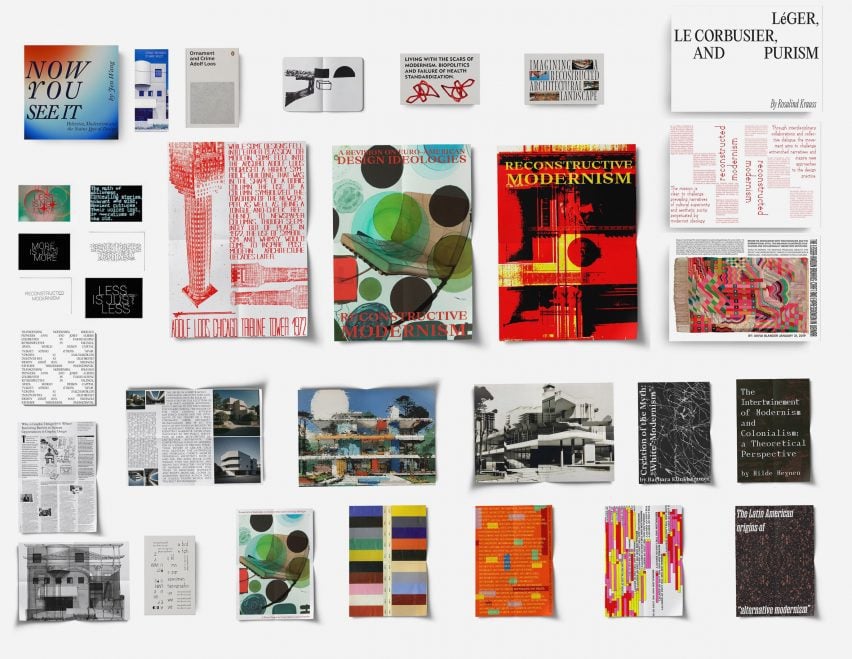
Reconstructed Modernism: A Revision on Euro-American Design Ideologies by Carlos (Charlie) Loaiza
“The thesis Reconstructive Modernism examines how the Western world has misrepresented classical antiquity to suit ideological needs of the Euro-American modern movement, resulting in significant social, aesthetic and cultural consequences.
“Through speculative design and revisionist analysis, it critiques the false narratives that portray modernism as pure and classical antiquity as idealised.
“The project advocates for a shift in both design aesthetics and ideology, challenging modernist values and promoting a more inclusive, nuanced approach to design.
“It seeks to reimagine 21st-century design by critically engaging with historical narratives and fostering reflective, innovative practices.”
Student: Carlos (Charlie) Loaiza
Course: Final Project Bachelor in Design
Email: cloaiza.ieu2020[at]student.ie.edu
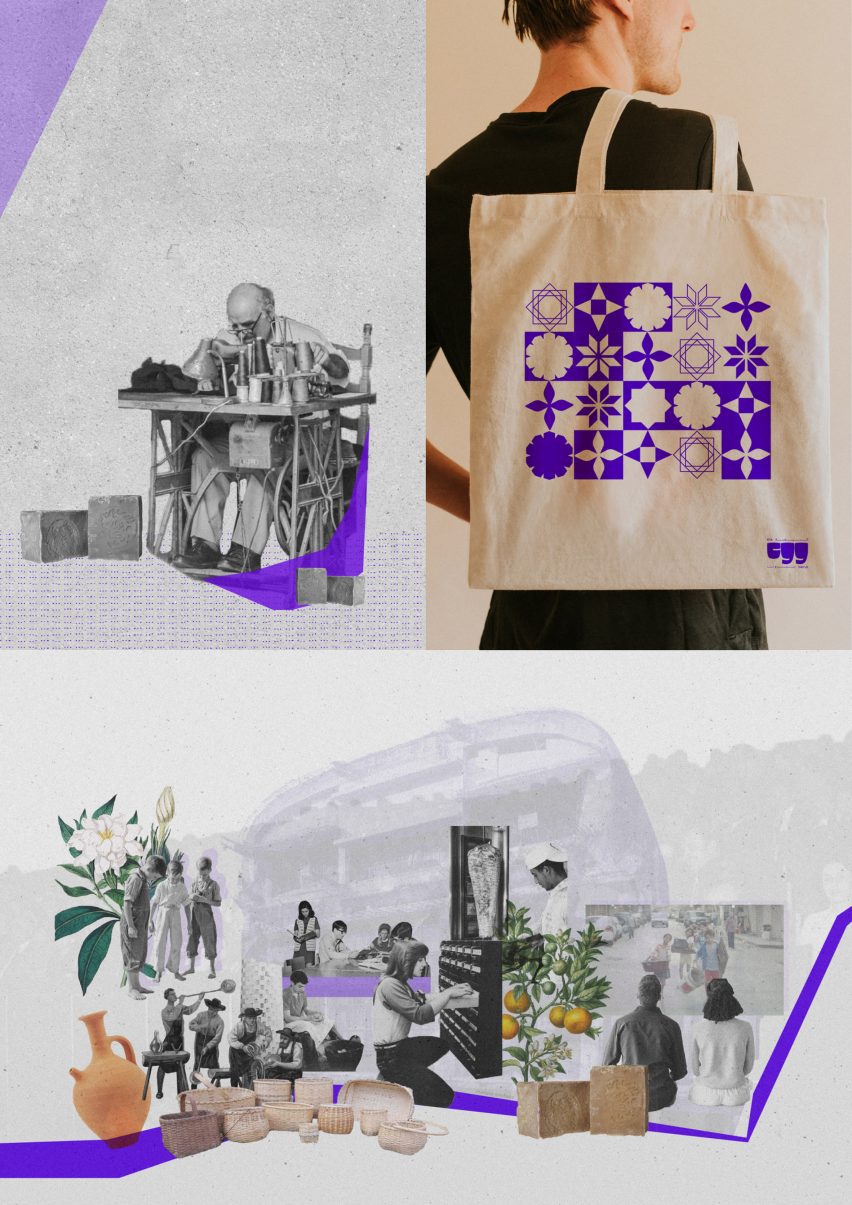
Memory Shells: Reconnecting Lebanese Post-War Generations to Lost National Belonging and Memory by Mariane Meshaka
“Memory Shells seeks to reconnect post-war generations in Lebanon to a lost sense of national identity by fostering collective memory through the rehabilitation of the Egg, an abandoned cinema on the former Green Line in Beirut.
“Once a sniper stronghold during the Lebanese Civil War, the Egg was reappropriated during the October 2019 Uprising as a social hub, symbolising unity, resistance and reclamation.
“This project leverages the cross-sectarian unity brought on by the uprising, aiming to transform the Egg into a space for inter-communal interactions and heritage preservation.
“By focusing on traditional crafts and shared cultural tools, Memory Shells hopes to heal sectarian divisions and build long-term collective memory, offering a platform for national reconciliation and unity.”
Student: Mariane Meshaka
Course: Final Project Bachelor in Design
Email: mmeshaka.ieu2020[at]student.ie.edu

Accelerating Pink by Alejandra Gabián, Ana Sánchez and Alejandra Olaguibel
“Accelerating Pink is a sustainable design project that reimagines the colour pink, traditionally associated with overconsumption in fast fashion, to address its environmental impact.
“The project envisions an interactive city in Plaza de España, Madrid, featuring recycling processes for textiles and plastics and sustainable pink pigments produced through bioengineering.
“Visitors can engage with the recycling process through playful activities, highlighting the project’s message that sustainability can coexist with creativity and fun, while encouraging reflection on the environmental consequences of fashion consumption.”
Students: Alejandra Gabián, Ana Sánchez and Alejandra Olaguibel
Course: Design Studio III
Emails: agabian.ieu2021[at]student.ie.edu and aolaguibel.ieu2021[a]student.ie.edu
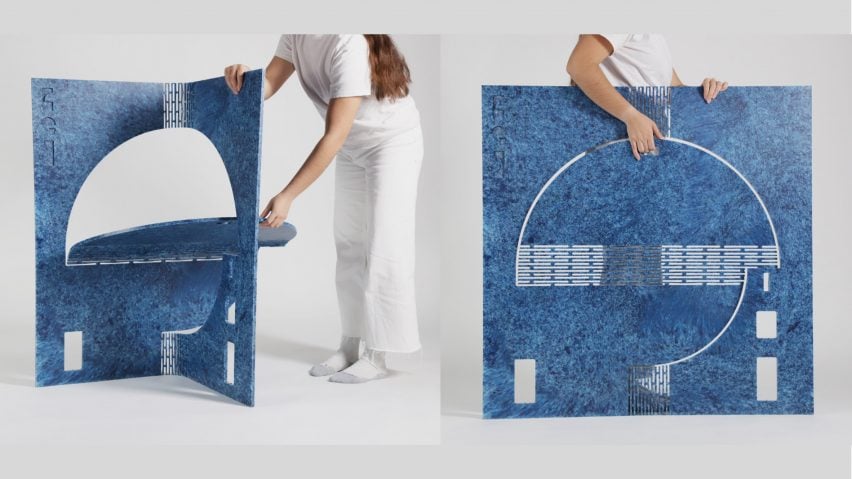
KIRI Table by Isabel Peña, Isabel Sanchez and Kayla Vinh
“The KIRI Table is a sustainable design project that repurposes recycled plastic from ghost fishing nets, aiming to raise awareness about ocean pollution.
“Inspired by the fluidity of the ocean, the design uses Kirigami techniques to transform flat plastic panels into dynamic shapes.
“The project follows a zero-waste approach, utilising all materials and even repurposing plastic shavings into a lampshade.
“It showcases how ocean waste can be transformed into functional and creative products, promoting sustainability and innovation.”
Students: Isabel Peña, Isabel Sanchez and Kayla Vinh
Course: Design Studio II
Emails: ipena.ieu2022[at]student.ie.edu and kvinh.ieu2022[at]student.ie.edu
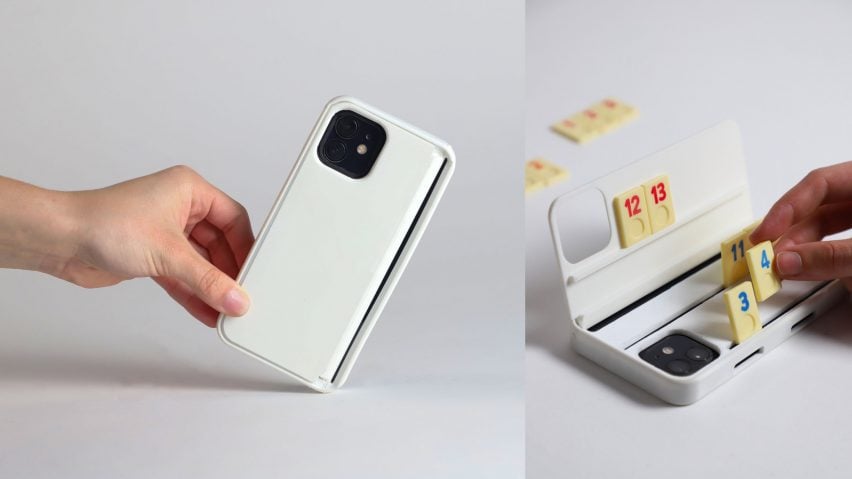
Another Round? by Candela del Barrio
“The project explores social media addiction and its impact on human interaction by creating a phone case designed to discourage phone use during in-person activities.
“Inspired by traditional board games, the case holds tokens, which fall out if the user picks up their phone while playing.
“This concept serves as a metaphor for prioritising real-life connections over digital distractions.
“The design highlights issues like social isolation and cognitive disruption, promoting meaningful interaction through a playful yet thought-provoking approach.”
Student: Candela del Barrio
Course: Design Studio II
Email: cdelbarrio.ieu2022[at]student.ie.edu
Partnership content
This school show is a partnership between Dezeen and IE University. Find out more about Dezeen partnership content here.

